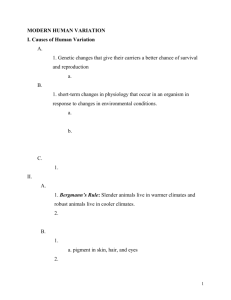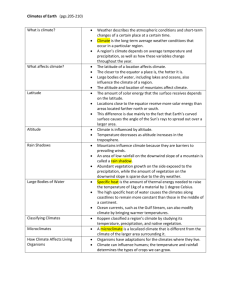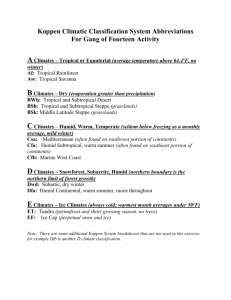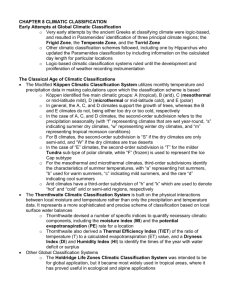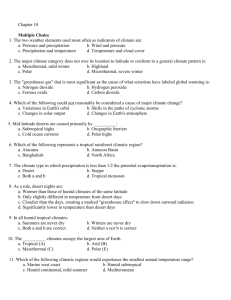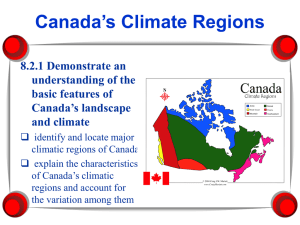LECTURE 5 - CLIMATIC CLASSIFICATION
advertisement
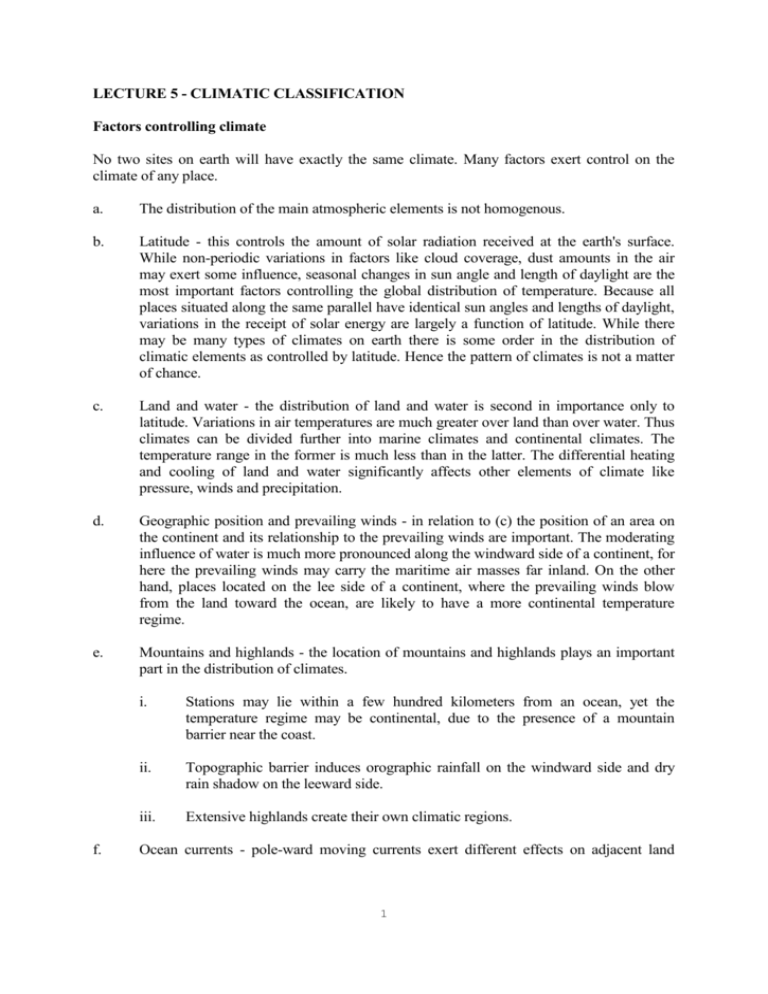
LECTURE 5 - CLIMATIC CLASSIFICATION Factors controlling climate No two sites on earth will have exactly the same climate. Many factors exert control on the climate of any place. a. The distribution of the main atmospheric elements is not homogenous. b. Latitude - this controls the amount of solar radiation received at the earth's surface. While non-periodic variations in factors like cloud coverage, dust amounts in the air may exert some influence, seasonal changes in sun angle and length of daylight are the most important factors controlling the global distribution of temperature. Because all places situated along the same parallel have identical sun angles and lengths of daylight, variations in the receipt of solar energy are largely a function of latitude. While there may be many types of climates on earth there is some order in the distribution of climatic elements as controlled by latitude. Hence the pattern of climates is not a matter of chance. c. Land and water - the distribution of land and water is second in importance only to latitude. Variations in air temperatures are much greater over land than over water. Thus climates can be divided further into marine climates and continental climates. The temperature range in the former is much less than in the latter. The differential heating and cooling of land and water significantly affects other elements of climate like pressure, winds and precipitation. d. Geographic position and prevailing winds - in relation to (c) the position of an area on the continent and its relationship to the prevailing winds are important. The moderating influence of water is much more pronounced along the windward side of a continent, for here the prevailing winds may carry the maritime air masses far inland. On the other hand, places located on the lee side of a continent, where the prevailing winds blow from the land toward the ocean, are likely to have a more continental temperature regime. e. Mountains and highlands - the location of mountains and highlands plays an important part in the distribution of climates. f. i. Stations may lie within a few hundred kilometers from an ocean, yet the temperature regime may be continental, due to the presence of a mountain barrier near the coast. ii. Topographic barrier induces orographic rainfall on the windward side and dry rain shadow on the leeward side. iii. Extensive highlands create their own climatic regions. Ocean currents - pole-ward moving currents exert different effects on adjacent land 1 areas from those that move towards the equator. In the case of the former, they cause air temperatures to be significantly warmer than would be expected, especially in winter. In the case of the latter, they reduce the temperatures of bordering coastal zones, causing stability of air masses resulting in marked aridity and often considerable advection fog. g. Pressure and wind systems - the world distribution of precipitation shows a close relationship to the distribution of the earth's major pressure and wind systems. i. The belt of equatorial low, the convergence of warm, moist and unstable air (ITCZ) makes this a zone of heavy rainfall. ii. In the subtropical highs, aridity prevails. iii. Mid-latitude zone is dominated by the irregular sub-polar low, many travelling cyclonic disturbances cause precipitation totals to rise. iv. In polar regions where temperatures are low, precipitation is also low. The seasonal shifting of the pressure and wind belts also has a significant effect on the areas situated in the intermediate positions, giving rise to marked seasonality of rainfall. Schemes of climatic classification Given the great number of possible climates on earth, and great variations within one area, some rationalisation, regionalisation and classification are required based on the climatic 'norm'. Climatic norms are computed from averages and extremes of weather elements compiled over a 30-year period. This concept may not be adequate since there are variations and extremes which must also be noted in order to portray the character of an area accurately. Using certain climatic parameters and formulae, climatologists have come out with several schemes of classification. One well known classification which has been used for 70 years was derived by Koppen (Table 4.1 and Figure 4.1). Another scheme was proposed by Thornthwaite. Temperature and precipitation are the most important elements in a climatic description because they have the greatest influence on people and their activities and also have an important impact on the broad-scale distribution of such items as vegetation and soils. Koppen's Classification Several attempts have been made to produce reasonable classification of climate and to show their distribution on world maps. Of all the major climatic classifications, the one provided by Koppen was the most well-known and has been used for the past 70 years. It has been widely accepted for several reasons: a. b. it uses only easily obtained data: mean monthly and annual values of temperature and precipitation. the criteria are unambiguous, relatively simple to apply, and divides the world into climatic regions in a realistic way. 2 Koppen believed the distribution of natural vegetation was the best expression of the totality of climate. Consequently, the boundaries he chose were largely based on the limits of certain plant associations. Five principal groups were recognized: each group was designated by a capital letter as follows: A. Humid tropical. Winterless climates; all months having a mean temperature of 18 oC. B. Dry. Climates where evaporation exceeds precipitation; there is a constant water deficiency. C. Humid middle-latitude. Mild winters; the average temperature of the coldest months is below 18 oC but above -3 oC. D. Humid middle-latitude. Severe winters; the average temperature of the coldest month is below -3 oC and the warmest monthly mean exceeds 10 oC. E. Polar. Summerless climates; the average temperature of the warmest month is below 10 o C. Each of the above five categories is further subdivided by using certain criteria and symbols. Koppen's system of classifying climates has been modified by himself and others in later years. It encompasses the basic design of the original Koppen system but with a variety of minor modifications. Thornthwaite's Classification Thornthwaite's classification of climate is less well known. It is based on the concept of potential evapotranspiration and the moisture budget. PE is calculated from the mean monthly temperature with corrections for day length or sunshine hours. For a 30-day month: PE = 1.6 (10t/I)a where: I = is the annual heat index ie sum for 12 months of i, where i = (t/5)1.514 and a = a is obtained from (6.75 x 10-7)I3 - (7.71 x 10-5)I2 + (0.0179 x 10-2)I + 0.492 The monthly water surplus (S) or deficit (D) is determined from the moisture budget assessment, taking into account stored soil moisture. A moisture index (Im) is given by: Im = (100S - 60D)/PE 3 The final classification and climatic types are defined thus: Im* PE >100 20 to 100 0 to 20 -33 to 0 -67 to -33 -100 to -67 Perhumid (A) Humid (B1 to B2) Moist Subhumid (C2) Dry Subhumid (C1) Semi-arid (D) Arid (E) >114 57 - 114 28.5 - 57 14.2 - 28.5 14.2 Megathermal (A') Mesothermal (B1' - B4') Microthermal (C1' - C2') Tundra (D') Frost (E') * Im = 100(S-D)/PE is equivalent to 100 (r/PE-1), where r = annual precipitation. Thornwaite's method of water balance analysis can also be carried out for individual stations and a diagramatic representation of the monthly moisture budget is as shown in Figure 4.3. Applications of such classification schemes a. General reference about climates, rather detailed with sub-classes b. Agricultural applications - in particular crop types with moisture requirements c. Climatic geomorphology and other environmental applications Reservations a. b. c. d. Anomalies and internal variability are not shown eg dry spells/seasons in the wet tropics. Do not take into consideration other elements of climate Some problems concerning transitional zones and marginal areas Data used not of uniform quality Types of climates Generally several main climatic types are discussed in any book on climatology. These are: a. b. c. d. e. f. g. h. The humid tropics Tropical monsoon Tropical Savanna Mediterranean Hot Arid Cool Temperate Tundra Polar Variations from these may include maritime and continental. Since standard texts are available on these it would be useful to read up the characteristics of each one of these climates. 4 Discussion 1. The climatic classifications employed in delineating climate types are rough regionalisations only. Do you agree? 2. Is the notion that 'the equatorial climate is hot and wet throughout the year ' correct? 3. Show how climate affects human activities in different parts of the world. 5

